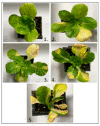Epigenetic Modulating Chemicals Significantly Affect the Virulence and Genetic Characteristics of the Bacterial Plant Pathogen Xanthomonas campestris pv. campestris
- PMID: 34070403
- PMCID: PMC8226645
- DOI: 10.3390/genes12060804
Epigenetic Modulating Chemicals Significantly Affect the Virulence and Genetic Characteristics of the Bacterial Plant Pathogen Xanthomonas campestris pv. campestris
Abstract
Epigenetics is the study of heritable alterations in phenotypes that are not caused by changes in DNA sequence. In the present study, we characterized the genetic and phenotypic alterations of the bacterial plant pathogen Xanthomonas campestris pv. campestris (Xcc) under different treatments with several epigenetic modulating chemicals. The use of DNA demethylating chemicals unambiguously caused a durable decrease in Xcc bacterial virulence, even after its reisolation from infected plants. The first-time use of chemicals to modify the activity of sirtuins also showed some noticeable results in terms of increasing bacterial virulence, but this effect was not typically stable. Changes in treated strains were also confirmed by using methylation sensitive amplification (MSAP), but with respect to registered SNPs induction, it was necessary to consider their contribution to the observed polymorphism. The molecular basis of the altered virulence was deciphered by using dualRNA-seq analysis of treated Xcc strains infecting Brassica rapa plants. The results of the present study should promote more intensive research in the generally understudied field of bacterial epigenetics, where artificially induced modification by epigenetic modulating chemicals can significantly increase the diversity of bacterial properties and potentially contribute to the further development of the fields, such as bacterial ecology and adaptation.
Keywords: DNA methylation; Xanthomonas campestris; bacterial epigenetics; dual RNA-seq; virulence.
Conflict of interest statement
The authors declare no conflict of interest. The funders had no role in the design of the study; in the collection, analyses, or interpretation of data; in the writing of the manuscript, or in the decision to publish the results.
Figures






References
-
- Latzel V., Janecek S., Dolezal J., Klimesova J., Bossdorf O. Adaptive transgenerational plasticity in the perennial Plantago lanceolata. Oikos. 2014;123:41–46. doi: 10.1111/j.1600-0706.2013.00537.x. - DOI
Publication types
MeSH terms
Substances
LinkOut - more resources
Full Text Sources

